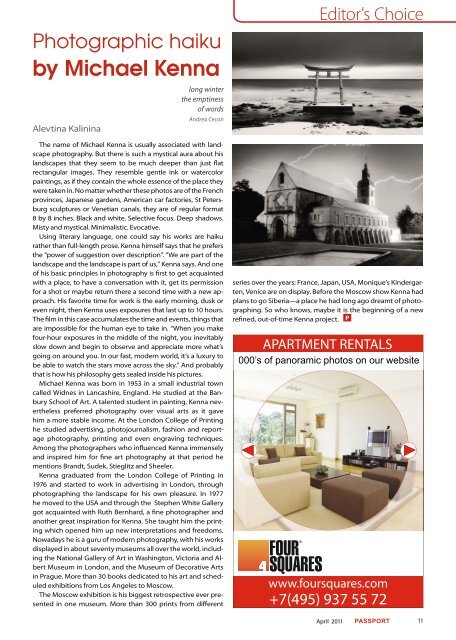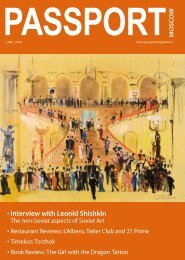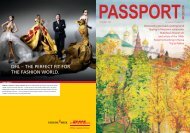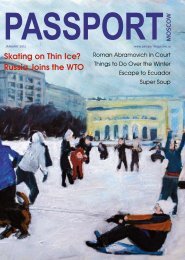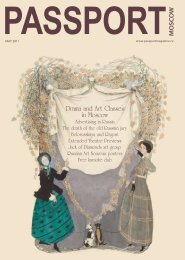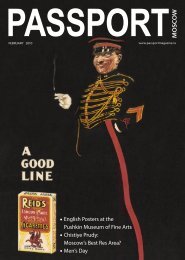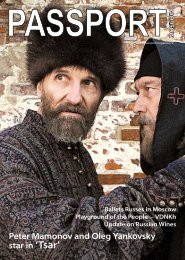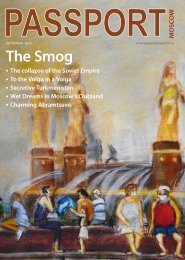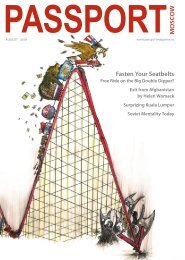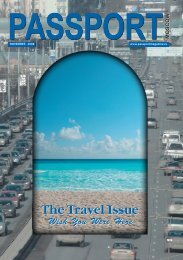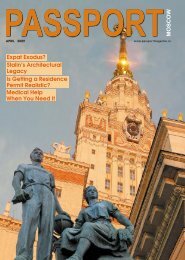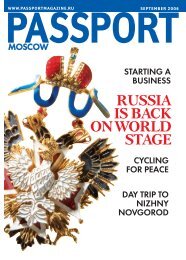Feminism in Russia - Passport magazine
Feminism in Russia - Passport magazine
Feminism in Russia - Passport magazine
Create successful ePaper yourself
Turn your PDF publications into a flip-book with our unique Google optimized e-Paper software.
Photographic haiku<br />
by Michael Kenna<br />
Alevt<strong>in</strong>a Kal<strong>in</strong><strong>in</strong>a<br />
long w<strong>in</strong>ter<br />
the empt<strong>in</strong>ess<br />
of words<br />
Andrea Cecon<br />
The name of Michael Kenna is usually associated with landscape<br />
photography. But there is such a mystical aura about his<br />
landscapes that they seem to be much deeper than just flat<br />
rectangular images. They resemble gentle <strong>in</strong>k or watercolor<br />
pa<strong>in</strong>t<strong>in</strong>gs, as if they conta<strong>in</strong> the whole essence of the place they<br />
were taken <strong>in</strong>. No matter whether these photos are of the French<br />
prov<strong>in</strong>ces, Japanese gardens, American car factories, St Petersburg<br />
sculptures or Venetian canals, they are of regular format<br />
8 by 8 <strong>in</strong>ches. Black and white. Selective focus. Deep shadows.<br />
Misty and mystical. M<strong>in</strong>imalistic. Evocative.<br />
Us<strong>in</strong>g literary language, one could say his works are haiku<br />
rather than full-length prose. Kenna himself says that he prefers<br />
the “power of suggestion over description”. “We are part of the<br />
landscape and the landscape is part of us,” Kenna says. And one<br />
of his basic pr<strong>in</strong>ciples <strong>in</strong> photography is first to get acqua<strong>in</strong>ted<br />
with a place, to have a conversation with it, get its permission<br />
for a shot or maybe return there a second time with a new approach.<br />
His favorite time for work is the early morn<strong>in</strong>g, dusk or<br />
even night, then Kenna uses exposures that last up to 10 hours.<br />
The film <strong>in</strong> this case accumulates the time and events, th<strong>in</strong>gs that<br />
are impossible for the human eye to take <strong>in</strong>. “When you make<br />
four-hour exposures <strong>in</strong> the middle of the night, you <strong>in</strong>evitably<br />
slow down and beg<strong>in</strong> to observe and appreciate more what’s<br />
go<strong>in</strong>g on around you. In our fast, modern world, it’s a luxury to<br />
be able to watch the stars move across the sky.” And probably<br />
that is how his philosophy gets sealed <strong>in</strong>side his pictures.<br />
Michael Kenna was born <strong>in</strong> 1953 <strong>in</strong> a small <strong>in</strong>dustrial town<br />
called Widnes <strong>in</strong> Lancashire, England. He studied at the Banbury<br />
School of Art. A talented student <strong>in</strong> pa<strong>in</strong>t<strong>in</strong>g, Kenna nevertheless<br />
preferred photography over visual arts as it gave<br />
him a more stable <strong>in</strong>come. At the London College of Pr<strong>in</strong>t<strong>in</strong>g<br />
he studied advertis<strong>in</strong>g, photojournalism, fashion and reportage<br />
photography, pr<strong>in</strong>t<strong>in</strong>g and even engrav<strong>in</strong>g techniques.<br />
Among the photographers who <strong>in</strong>fluenced Kenna immensely<br />
and <strong>in</strong>spired him for f<strong>in</strong>e art photography at that period he<br />
mentions Brandt, Sudek, Stieglitz and Sheeler.<br />
Kenna graduated from the London College of Pr<strong>in</strong>t<strong>in</strong>g <strong>in</strong><br />
1976 and started to work <strong>in</strong> advertis<strong>in</strong>g <strong>in</strong> London, through<br />
photograph<strong>in</strong>g the landscape for his own pleasure. In 1977<br />
he moved to the USA and through the Stephen White Gallery<br />
got acqua<strong>in</strong>ted with Ruth Bernhard, a f<strong>in</strong>e photographer and<br />
another great <strong>in</strong>spiration for Kenna. She taught him the pr<strong>in</strong>t<strong>in</strong>g<br />
which opened him up new <strong>in</strong>terpretations and freedoms.<br />
Nowadays he is a guru of modern photography, with his works<br />
displayed <strong>in</strong> about seventy museums all over the world, <strong>in</strong>clud<strong>in</strong>g<br />
the National Gallery of Art <strong>in</strong> Wash<strong>in</strong>gton, Victoria and Albert<br />
Museum <strong>in</strong> London, and the Museum of Decorative Arts<br />
<strong>in</strong> Prague. More than 30 books dedicated to his art and scheduled<br />
exhibitions from Los Angeles to Moscow.<br />
The Moscow exhibition is his biggest retrospective ever presented<br />
<strong>in</strong> one museum. More than 300 pr<strong>in</strong>ts from different<br />
Editor’s Choice<br />
series over the years: France, Japan, USA, Monique’s K<strong>in</strong>dergarten,<br />
Venice are on display. Before the Moscow show Kenna had<br />
plans to go Siberia—a place he had long ago dreamt of photograph<strong>in</strong>g.<br />
So who knows, maybe it is the beg<strong>in</strong>n<strong>in</strong>g of a new<br />
ref<strong>in</strong>ed, out-of-time Kenna project. P<br />
April 2011<br />
11


